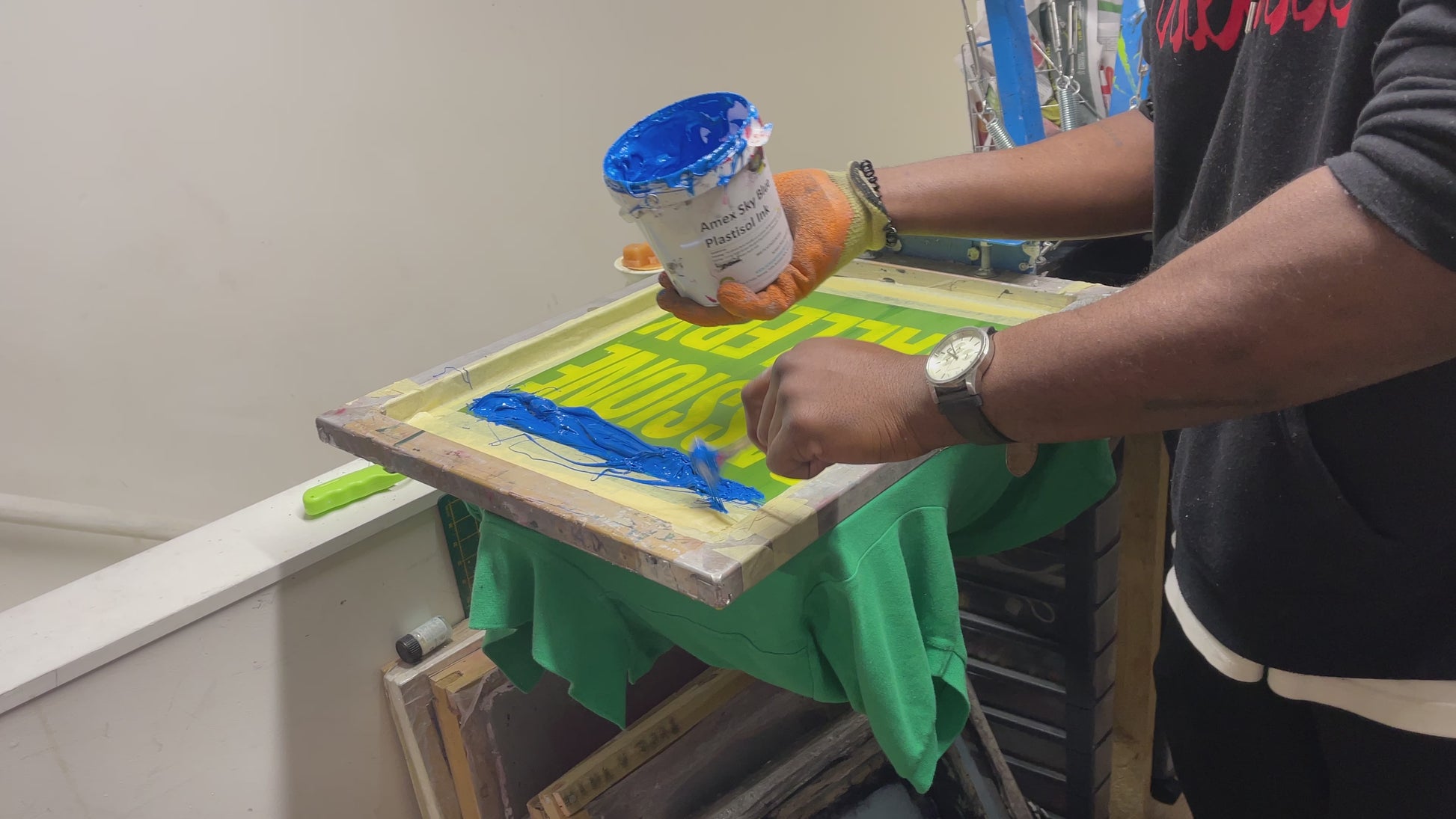Complete Screen Printing Kit for Artists and Creators
Complete Screen Printing Kit for Artists and Creators
Blog Article
Display Printing Uncovered: Whatever You Need to Understand About Tee and Garment Printing Techniques
If you have actually ever before asked yourself just how those dynamic layouts wind up on your favorite t-shirts, you remain in the right area. Screen printing is an interesting technique that integrates art with strategy, using unlimited possibilities for imagination. Recognizing the fundamentals, from tools to ink options, can significantly affect your outcomes. Prepared to explore the vital aspects that make display publishing an art kind? Let's uncover the information that can boost your jobs.
The Essentials of Screen Printing: How It Functions
When you plunge into screen printing, you'll uncover it's both a science and an art. At its core, display printing includes producing a stencil, or screen, that allows ink to travel through only in certain areas (screen printing kit). You start by choosing your layout and preparing your screen with a light-sensitive solution. As soon as you expose this solution to light, it solidifies, leaving your layout as an adverse room.
Setting the screen over the material, after that utilize a squeegee to press ink with the display onto the garment. Each action is important, and mastering them will elevate your display printing abilities, transforming basic garments right into one-of-a-kind, meaningful items.
Kinds of Display Printing Techniques
As soon as you comprehend the essentials of display printing, it's time to explore the different techniques that can raise your layouts. One prominent method is conventional display printing, where ink is pressed through a stenciled screen.
If you're going for great details, think about discharge printing. This technique eliminates dye from the fabric, leaving a soft, classic look. Another choice is plastisol printing, recognized for its toughness and brilliant shades, making it a favorite for several brands. Lastly, experiment with halftone printing to develop slope results and intricate styles. Each strategy has its special beauty, so don't think twice to attempt them bent on discover what suits your design best!
Vital Devices for Display Printing
To achieve sensational results in display printing, having the best equipment is fundamental. Initially, you'll require a sturdy display printing frame, which holds the mesh that transfers your style onto the garment. Next, buy top notch mops; these are crucial for applying ink uniformly throughout the display. You'll likewise call for a great direct exposure unit to develop your displays, as well as a washout cubicle for cleaning them after usage. A dependable warm source, like a conveyor dryer or heat press, is crucial for curing your prints to guarantee long life. Do not forget a proper work space, outfitted with tables and storage space for your supplies. Lastly, safety equipment, such as handwear covers and masks, will certainly maintain you safe from chemicals and inks. With the right devices, you'll be well on your way to creating professional-quality prints.
Choosing the Right Inks and Products
When selecting inks and materials for screen printing, you need to think about the kind of ink that functions ideal for your project. Assume regarding fabric compatibility to guarantee your styles look last and wonderful lengthy. Likewise, explore environmentally friendly ink choices to make your printing process a lot more sustainable.
Kinds Of Screen Inks
Selecting the ideal screen ink is essential for attaining dynamic, sturdy prints that satisfy your project's demands. There are numerous types of display inks to take a look at. Specialty inks, such as metal or glow-in-the-dark, can include one-of-a-kind impacts to your styles.

Fabric Compatibility Considerations
Comprehending fabric compatibility is essential for accomplishing top quality screen prints, specifically given that various materials react uniquely to various inks. When picking inks, take into consideration the textile kind-- cotton, polyester, or blends. For cotton, water-based inks function well, providing soft qualities and breathability. Polyester, on the various other hand, typically calls for plastisol inks for far better attachment and vibrant colors. You may need to use a mix of both types if you're printing on blends. Always evaluate your inks on example fabric to ensure they adhere correctly and preserve shade honesty. Additionally, maintain in mind that material weight and structure can impact the final end result, so picking the ideal ink and product combination is essential for your task's success.
Eco-Friendly Ink Options
Green inks are becoming a prominent option for screen printers that wish to lessen their ecological influence while keeping top quality. When selecting inks, think about water-based inks, which are much less damaging and simpler to cleanse up contrasted to traditional solvents. These inks bond well with fabrics, providing lively outcomes without hazardous chemicals. You could likewise discover eco-solvent inks that utilize less volatile natural compounds (VOCs), making them a much safer choice for both your wellness and the planet.
In addition, try to find inks made from renewable energies, such as soy or vegetable-based options. By choosing the right inks and products, you'll not only create spectacular styles however additionally contribute to a more sustainable printing procedure. Make the switch, and your prints will certainly reflect your dedication to the atmosphere!
Preparing Your Layout for Screen Printing

Submit Layout Requirements
To assure your style looks sharp and dynamic on material, you'll need to pay very close attention to file format needs for screen printing. Begin with vector documents like AI or EPS, as they can be scaled without losing high quality. If you utilize raster photos, select high-resolution data, such as TIFF or PNG, ideally at 300 DPI. Stay clear of using JPEGs, as they can shed clearness when resized. Make certain your design has a transparent history to stop unwanted white sides on your prints. Finally, maintain color modes in mind; CMYK is common for display printing, so transform your RGB designs accordingly. By following these guidelines, you'll set your artwork up for a successful print.
Shade Separation Strategies
Shade splitting up is an essential action in preparing your style for screen printing, and understanding it can substantially enhance your print high quality. You'll require to damage your layout into specific shades, as each color calls for a different screen throughout printing. Start by recognizing all the colors in your design and produce layers for each one. You can make use of software program like Adobe Photoshop or Illustrator to separate and different shades successfully. Be certain to conserve each layer as a separate documents, commonly in a format like TIFF or PSD. This accuracy not only guarantees precise shade representation yet additionally simplifies the printing procedure. By taking note of color separation, you'll attain expert and vivid cause your screen-printed garments.
Resolution and Size
Achieving the very best cause screen printing begins with ensuring your style has the appropriate resolution and dimension. Preferably, your art work needs to go to least 300 DPI (dots per inch) for sharp, clear prints. Your final product may look amateur and pixelated. if you utilize lower resolution.
When it concerns size, consider the measurements of your print location. Layout your artwork to match the last print dimension, preferably developing it in the real measurements you'll be publishing. In this manner, you'll prevent any type of unexpected scaling concerns.
Constantly examine your style in both vector and raster formats. Vector graphics can be scaled without losing high quality, making them optimal for screen printing. Preparing properly will ensure your design looks remarkable on every garment!
Step-by-Step Screen Printing Refine
Screen printing is a vibrant process that allows you to produce vibrant styles on different surfaces. To obtain begun, you'll require a screen, emulsion, and your selected ink. Initially, prepare your screen by cleansing it completely. Next, apply the emulsion evenly and let it completely dry in a dark location. As soon as dry, reveal my explanation your display to light with your design put on it, which will certainly set the solution where the light hits, creating a pattern - screen printing kit.
Put ink onto the display and make use of a squeegee to push the ink through the pattern onto the textile. Lift the display carefully and allow the print completely dry. You have actually efficiently screen published your design.
Tips for Successful Screen Printing Projects
While you're diving into your screen printing projects, keep in mind that preparation is crucial to success. Start by collecting all your products-- inks, squeegees, screens, and garments. A tidy work space aids protect against undesirable mistakes, so clean prior to you begin.
Next, validate your artwork is high-resolution and correctly sized for your garment. Test your screen for proper direct exposure and clean it thoroughly to prevent spots. When blending your inks, follow the supplier's guidelines to attain the appropriate consistency.
During printing, apply also stress with your squeegee for regular outcomes. Do not hurry; take your time to verify each print fulfills your criteria. After printing, allow your garments completely dry entirely before handling or packaging them.
Finally, always keep an example of your job for future referral. In this manner, you can assess your development and boost your strategies over time. Satisfied printing!

Regularly Asked Concerns
Exactly how Lengthy Does It Require To Establish up a Screen Printing Job?
Setting up a display printing task generally takes about thirty minutes to an hour. You'll prepare the displays, mix inks, and change journalism. The time differs based upon intricacy and experience, so remain arranged!
Can I Publish on Various Fabric Types Using the Exact Same Strategy?
Yes, you can publish on various material types making use of the exact same technique, but you'll need to change your inks and settings. Some materials take in ink differently, so experimenting guarantees the very best results for each product.
What Prevail Mistakes to Prevent in Display Printing?
When screen printing, stay clear of typical blunders like using the wrong ink, disregarding appropriate exposure times, or avoiding pre-press checks. Constantly check your arrangement and maintain tidy displays to ensure quality results each time.
Just How Can I Appropriately Clean and Maintain My Screen Printing Tools?
To effectively tidy and maintain your display printing tools, you ought to on a regular basis wash screens with appropriate solvents, examine squeegees for wear, and ensure all tools are stored dry and dust-free. Uniformity boosts and protects against pricey fixings performance.
Is Screen Printing Eco-friendly Contrasted to Other Approaches?
Display printing can be much more eco friendly than other techniques, particularly if you utilize water-based inks and eco-conscious products. By choosing lasting supplies and techniques, you reduce waste and decrease your impact on the earth.
Screen Printing Uncovered: Every Little Thing You Need to Know Regarding Tee Shirt and Garment Printing Strategies
At its core, screen printing includes creating a pattern, Continued or screen, that permits ink to pass with only in details locations. Setting the screen over the textile, after that utilize a squeegee to press ink with the display onto the garment. One popular approach is conventional display printing, where ink is pushed through a stenciled display.When picking inks and products for screen printing, you require to take into account the type of ink that functions finest for your project.
Report this page